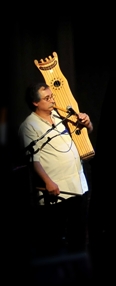
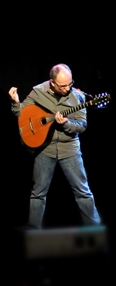
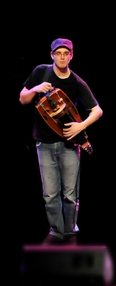
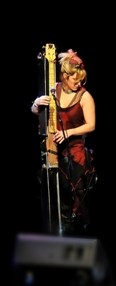
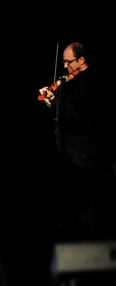
FolkWorld Issue 42 07/2010; Article by Eelco Schilder





|
A band like Xarnege reminds me of the fact that the official country borders we have now were different during the past. This band is an example of how an ancient, South-European culture is kept alive. With their music from Vasconia they reconstruct the sounds of a, by many people, forgotten country and place it in today’s world. I spoke with Juan Ezeiza, one of the musicians that participate in this band. He tells about the Basque and Gascony culture that are part of the ancient Vasconia.
It’s my curiosity that always makes me ask the same question to start with. I want to get a bit of inside information about the person I’m interviewing, so I had to ask Juan Ezeiza about his musical past, and, oh yes, he told me his age to.
‘I’m 45 years old and, although I don’t come from a family of musicians, at home we heard many different styles from rock, classic, folk to jazz. I liked Steeleye Span, Pentangle, Malicorne, The Chieftains, The Beatles, Deep Purple, Led Zeppelin, Oskorri, Benito Lertxundi, Susato and sort like.
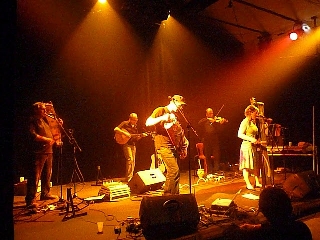 Xarnege @ FolkWorld: FW#41, #42
|
The band Xarnege doesn’t focus on the Basque traditional music alone, but mix this with the music from Gascony. What is the story behind this mixture of two cultures?
‘Our guitarist Josean Martin knew Joan Baudoin because he collaborated playing the hurdy-gurdy on one of the Ganbara albums. When Baudoin came to the Basque country to give a concert in 2003, they performed traditional music from the Gascony. Josean was there and he was surprised because they played some “Basque” dances in a different way and sang a “Basque” song in Gascony language. But in fact, those songs and dances where traditional in both cultures. Josean told me about the concert and
we had lunch together, Basque and Gascony people decide almost everything eating and drinking, and there we decided to begin a group together. Xarnege or Sharnègo, is a Gascony word which refers to villages on the Gascony and Basque border where people express themselves in both the languages.
We recorded our first CD, Gaueko lan musika – Musica de contrabanda (Smuggled Music), in 2004. We had concerts in Spain, France, Portugal, Flanders, Italy, Switzerland and Mexico. This album was the first approach to our sound. It was a bit more heterogeneous than the second one. Two of the musicians are different and this gives another colour to the band. And nowadays we are working with more electric effects than on the first album. The material for the albums is usually proposed by one of the musicians. Most of the time this is a traditional tune he has found in a book or heard somewhere. When we all like it, we start arranging it. We play it a few times and try how a tune sounds when we play it in different combinations of instruments. This process takes a long time, but it doesn’t matter, because we make our rehearsals at Joan’s home and he’s a very good cook! When we feel happy with the arrangement we play the new song on stage and see the reaction of the public.’
Can you explain the difference and the similarities between the two cultures?
‘Gascony and Basque traditions are different but they have the same origin: the ancient Vasconia. For this reason we always say that our music is “made in Vasconia”.
In both cultures three-holed flutes, string-drums and fiddles are played. The sound of the alboka (Basque horn) is not far from the boha (Gascony pipe). There are some dances that only exist in both cultures. This is the case of the “sauts” (in Gascony) or “jauziak” (in Basque). On the other hand, the “sonsaina” (hurdy-gurdy) is very common in Gascony, but almost unknown in the Basque Country.
We both are a cultural minority, who try to protect their languages, their dances, music and traditions. There are many similarities and many differences, but there are many differences inside the Basque or the Gascony cultures too. 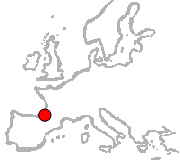 The variety and the richness of the Pyrenean cultures is astonishing.
We have many friends in the Basque and Gascony traditional music, but as far as we know we are the only ones mixing these two cultures. Better than a mixture, we prefer to say that Xarnege is a meeting place. A crossroads not a fence, a look to the future from the roots, not an inert museum. We hope there won’t be any accident at our crossroads.’
The variety and the richness of the Pyrenean cultures is astonishing.
We have many friends in the Basque and Gascony traditional music, but as far as we know we are the only ones mixing these two cultures. Better than a mixture, we prefer to say that Xarnege is a meeting place. A crossroads not a fence, a look to the future from the roots, not an inert museum. We hope there won’t be any accident at our crossroads.’
But do people in your own countries recognise the tradition? How do they react on your music?
‘They use to react with surprise, because they recognise some of the instruments and tunes but not the others. At the end of the performance we use to invite the public to approach and see the instruments. Basque people find the hurdy-gurdy very exotic. Gascony people have the same reaction with the alboka, for example. Sometimes we link up Basque and Gascony dances and the public goes on dancing as if they knew all of them.’
What about the future? Any wild plans? And is there at least a small chance for a Dutch concert?
‘We want to play in new places, to know new people and continue doing what we love: playing traditional music. In September we’ll go to the festival “Chants de Vielles” in Québec, there’s a possibility to go to Brazil, and we hope we’ll have many concerts in Europe. We have played at Gooikoorts and Dranouter festivals, in Flanders, not far from Holland, and the reaction of the audience was very good, but we haven’t played in Holland. We would like to do it. If there’s a telephone call from Holland the answer will be ‘ja’!’
Photo Credits:
(1)-(6) Xarnege (from website);
(7) Duchy of Vasconia
(by FolkWorld).
|
To the German FolkWorld |
© The Mollis - Editors of FolkWorld; Published 07/2010
All material published in FolkWorld is © The Author via FolkWorld. Storage for private use is allowed and welcome. Reviews and extracts of up to 200 words may be freely quoted and reproduced, if source and author are acknowledged. For any other reproduction please ask the Editors for permission. Although any external links from FolkWorld are chosen with greatest care, FolkWorld and its editors do not take any responsibility for the content of the linked external websites.
